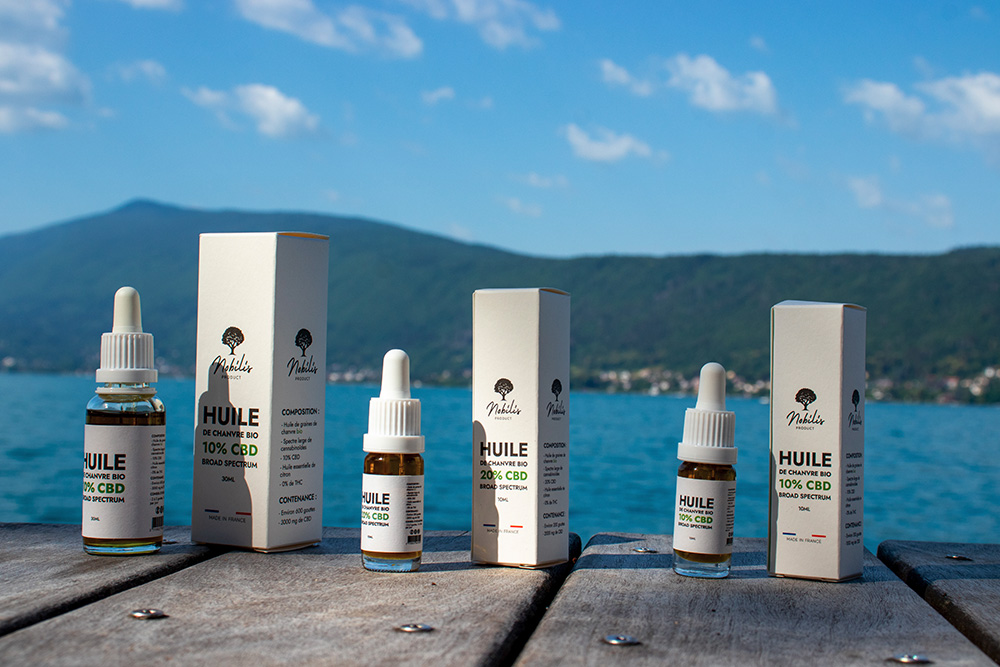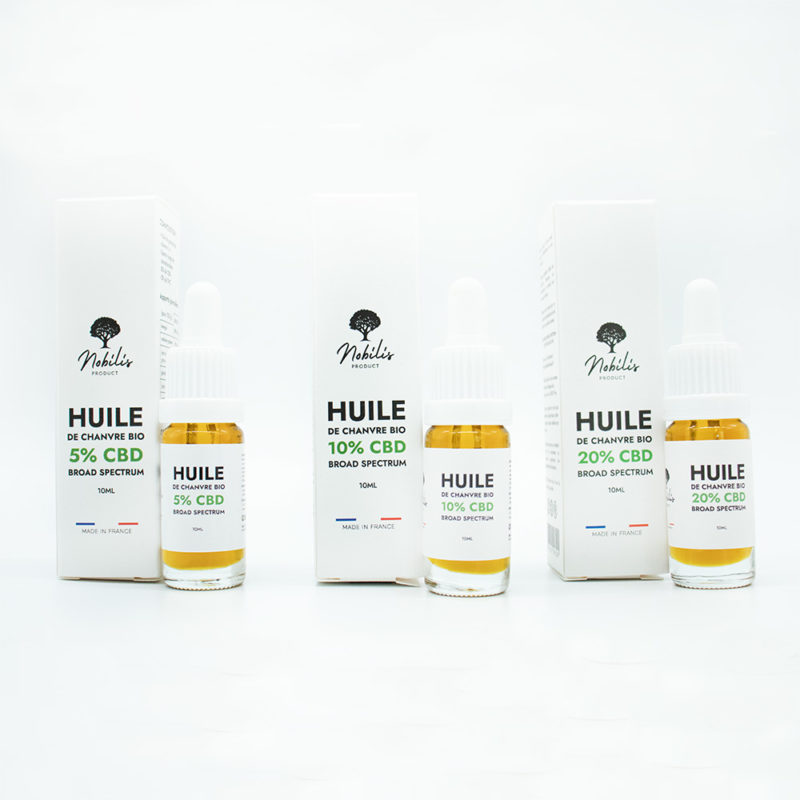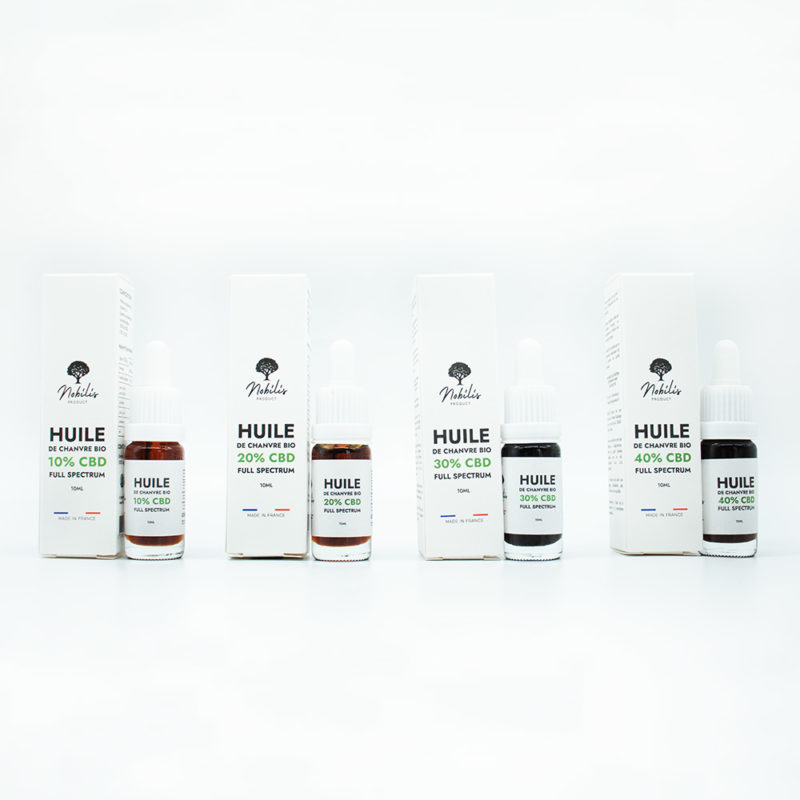CBD is available over the counter, and you'll have no trouble getting your hands on it. Whether on the Internet or in a specialist store, there's plenty to choose from! The only hitch is that it's not always easy to tell the difference between one serious brand and another. This is made all the more difficult by the fact that there are very few regulatory quality controls. Indeed, the only standard imposed on CBD sellers and retailers is the THC content, which must be less than 0.3%.
At Nobilis Product, we believe in encouraging newcomers, but we know that developing a quality product requires both expertise and financial resources.Our CBD oil is the result of many years' hard work. And we recommend giving preference to experienced producers whose adventure began long before the fad of recent years.
As growers, we also know how rare CBD and quality cannabis extract are. In order to maximize productivity, some growers opt for intensive cultivation and use extraction methods that are not necessarily very healthy.
As far as we're concerned, we're hemp farmers who respect the environment, and the farms we work with have been scrupulously selected. We invite you to choose brands that follow this same approach.
Cannabis sativa is a medicinal plant that has been used for thousands of years, but has only recently come under scientific scrutiny. Indeed, it was long after the interest aroused by opiates that the first microscopes began to study the pharmacology of THC. But the molecule's lipophilic nature was disconcerting, and discoveries were made by trial and error.
It's only a quarter of a century after its discovery that scientists are crying eureka. A team from the Saint Louis School of Medicine (U.S.) isolated a receptor activated by THC. This was the first step towards the discovery of the endocannabinoid system.
CONTENTS
What is the endocannabinoid system?
Like the immune and nervous systems, the endocannabinoid system (ECS) is a vast communication network of receptors and neurotransmitters. All vertebrates are equipped with them, making this a major discovery with infinite potential.
THC, anandamide and the CB1 receptor
In 1981, Professor Allyn Howlett and his student William Devane (Saint Louis University, U.S.) discovered that THC binds to a very specific receptor in rat brains. They named it CB1(cannabinoid receptor type 1).
Mainly located in the central nervous system, the CB1 receptor seems to act on stress levels and pain perception. When THC binds to this receptor, it is responsible for the well-known psychotropic effects .
Animals are therefore equipped with receptors specifically designed to react with a substance of plant origin. Strange. Scientists therefore hypothesized that there must be an endogenous substance, i.e., synthesized by the body, capable of reacting with CB1-type receptors.
The theory was validated almost 10 years later, when Dr. Mechoulam and his team isolated an endogenous neurotransmitter capable of reacting with the CB1 receptor: N-arachidonoylethanolamide (AEA). They named it anandamidewhich means "bliss" in Sanskrit, in reference to its action on the central nervous system.
THC and anandamide are two very different neurotransmitters, but that doesn't prevent them from reacting with the same receptor. Indeed, a receptor is a kind of lock that can be opened or closed by several specific keys. In this case, THC and anandamide are two keys that open - they're both agonists - the CB1 lock.
Subsequent research has shown that the CB1 receptor also influences appetite, moods, glucose metabolism and evenovulation. This discovery and its therapeutic potential motivated scientists to continue their research. They discovered that the endocannabinoid system involves more than just the CB1 receptor.
CBD, 2 - AG and the CB2 receptor
In 1993, researchers observed a new type of receptor they called CB2(cannabinoid receptor type 2). Located throughout the body, these receptors appear to be involved in the metabolism of immune reactions such as inflammation, as well as in pain perception in the peripheral nervous system.
Two years later, scientists isolated the endogenous ligand linked to the CB2 receptor: 2 - AG. At the same time, they discovered that this neurotransmitter is present in very large quantities throughout the body, as well as in the brain. Even more potent than anandamide, 2 - AG is also able to bind to CB1 receptors.
Until then, cannabidiol (CBD), which is present in large quantities in cannabis, had been of little interest to the scientific community. It wasn't until the realization that the molecule was capable of inhibiting the psychotropic effect of THC that it gained the interest of the community.
In fact, CBD binds to THC and attaches itself to CB2-type receptors , preventing the latter from reacting with CB1-type receptors, responsible for the euphoric and hallucinatory effects. From there, the spotlight shone on CBD. The molecule would activate CB1 and CB2 receptors while inhibiting the harmful effects of THC.
Cannabinoids and TRPV1 and PPAR receptors
When Raphaël Mechoulam identified the chemical structure of cannabis' active substances in 1964, he described the plant as a pharmacological treasure trove. In his image, the endocannabinoid system extends far beyond the CB1 and CB2 receptors. Indeed, scientists are constantly discovering new receptors with which cannabinoids can react.
In 1999, researchers realized that anandamide, 2 - AG and CBD react with another well-known type of receptor: TRPV1 vanilloids. These receptors belong to the large family of TRP receptors, which are sensitive to mechanical and thermal stimuli. TRPV1 are involved in nociceptive mechanisms, i.e. sensitivity to pain.
A few years later, it was discovered that cannabinoids react with a fourth type of receptor: PPAR-gamma. Present in the nucleus of our cells, these receptors regulate fatty acid storage and act on glucose metabolism. Substances that activate these receptors (including cannabinoids) are thought to inhibit the development of certain cancers, combat obesity and treat diabetes.
The endocannabinoid system is complex, and much remains to be discovered. Moreover, we've recently realized that cannabinoids aren 't the only molecules likely to react with SEC.
Endo, phytocannabinoids and terpenes
So far, we know that the endocannabinoid system reacts with two major cannabinoid families:
- Endocannabinoids, i.e. cannabinoids synthesized naturally in the bodies of all vertebrates. To date, two of these are known: anandamide and 2-AG. However, researchers are realizing that there are other endogenous substances capable of reacting with SEC receptors. These are not phytocannabinoids, but their structure is similar. They are called "cannabinoid-like".
- Phytocannabinoids are cannabinoids synthesized in the plant kingdom, mainly in the flowers of Cannabis sativa L.. There are over a hundred of them, the two best known being THC and CBD, as they are present in large quantities. However, other phytocannabinoids are also of interest, such as cannabinol (CBN), cannabigerol (CBG) and cannabichromene (CBC).
Cannabis, like all plants, synthesizes numerous substances. Among these are terpenes, which are responsible for the smell and taste of the plant.
A recent American study investigated the effects of cannabis terpenes on the body. The scientists concluded that terpenes also act on the endocannabinoid system, although these mechanisms are still unclear. They also validated the "entourage effect" theory, according to which cannabinoids are more effective when in the presence of terpenes.
What role does the endocannabinoid system play in the body?
The endocannabinoid system is complex. Here's what you need to remember so far:
- All vertebrates have them;
- CB1 and CB2 are the two main types of receptors of which it is composed;
- They react mainly with substances present in cannabis and with certain substances synthesized in the body;
Localization of CB1 and CB2 receptors in the body
Receptors of the endocannabinoid system are present in virtually every cell of our body. They are found in the organs and tissues of the central and peripheral nervous systems, the immune system, the digestive system, the respiratory system, the cardiovascular system and the reproductive system. In short, just about everywhere!
Both CB1 and CB2 receptors are found in the liver, bone marrow and pancreas. In the rest of the body, however, the two receptors appear to be distributed independently.
- CB1 receptors are mainly found in the brain, but also in the lungs, muscle tissue, vascular system and ovaries.
- CB2 receptors are found in the spleen, bones and skin.
Homeostasis
Receptor location is a clue to the action and effects they have on metabolism and all the chemical processes carried out in the body. Indeed, as already mentioned, it is the CB1 receptors that trigger the psychotropic effects observed when THC is consumed. This is because CB1 is located in the brain, and can therefore modify its chemistry.
Nevertheless, this is an effect caused by an exogenous substance. To understand the role of the endocannabinoid system, we need to look at the reactions caused by the endocannabinoids we naturally synthesize in our bodies.
Scientists have observed that levels of anandamide and 2 - AG are not constant. It would appear that the body releases these cannabinoids for specific purposes, and then, once the mission has been accomplished, they are degraded. Based on this observation, combined with the fact that receptors are found everywhere in the body, it is now thought that the endocannabinoid system plays a regulatory role.
Our SEC is responsible for maintaining our organism in an ideal state of equilibrium. In biology, this is known as homeostasis. More precisely: homeostasis is a phenomenon whereby a key factor is maintained around a value that is beneficial to the system in question, thanks to a regulatory process.
CBD's therapeutic potential and research
If the endocannabinoid system is capable of regulating our physiological functions, then the therapeutic applications of cannabinoids are... infinite, or almost!
To date, there are two drugs formulated with synthetic THC and/or CBD.
- The best-known is Epidiolex, a cannabidiol-based treatment prescribed to people with certain forms of epilepsy. In certain circumstances, this antiepileptic can significantly reduce the intensity and frequency of epileptic seizures.
- Sativex is a spray-packaged medicine formulated from cannabis extracts, containing both THC and CBD. It is prescribed for people suffering from muscle stiffness caused by multiple sclerosis.
Both drugs are approved for use in the EU, but are prescribed only on prescription and under very strict conditions. Cannabinoids are not yet fully understood, let alone the functioning of the endocannabinoid system.
However, scientific research is in full swing, and several possible therapeutic applications have already been identified to treat :
- Neurodegenerative diseases: multiple sclerosis, Alzheimer's and Parkinson's ;
- Stress and anxiety: notably thanks to its relaxing properties in the treatment of epileptic seizures;
- Chronic pain caused by fibromyalgia, rheumatism and arthritis;
- Certain psychiatric disorders, such as schizophrenia.
Choosing CBD oil for good health?
CBD owes much of its success to its action on the endocannabinoid system. Indeed, most consumers are motivated by CBD's potential health benefits. Sports enthusiasts, young professionals with hectic lifestyles, the elderly and even dogs and cats use CBDoil to treat everyday ailments or keep fit, whether in its full-spectrum or broad-spectrum form, or using specific innovative formulations.
Endocannabinoid deficiency theory
We know that the role of the endocannabinoid system is to keep body and mind healthy. However, to date, there is no scientific evidence to suggest that this is also the case with CBD.
There is, however, an interesting theory in the process of being validated, that of clinical endocannabinoid deficiency (CECD).
Formulated by Dr. Ethan Russo, this theory is based on a very simple observation: endocannabinoid deficiency seems to be the common denominator of several diseases. This is particularly the case with fibromyalgia, migraines and irritable bowel syndrome.
According to this doctor, if this deficiency could be avoided, then the endocannabinoid system would function in optimal conditions, which could prevent many health problems. As a result, he believes that consuming cannabis extract could enable healthy people to maintain good health.
Full spectrum CBD oil, which contains all the plant's cannabinoids as well as terpenes, could therefore be a major wellness ally.
A CBD cure to stimulate the endocannabinoid system?
At Nobilis, we're all passionate about our products, but we're not doctors. We can therefore only share with you the various testimonials of our customers, which in no way constitute proof of the efficacy of CBD oil in maintaining good health.
Most people who consume CBD regularly observe an overall improvement in their well-being:
- Anxious and stressed people feel more serene, have less difficulty concentrating and find it easier to fall into the arms of Morpheus in the evening;
- People suffering from chronic pain, generally in the joints, feel less intense, less tired and in a better moodoverall;
- Some depressed people feel happier, more inclined to action and to contact with others;
- Finally, many athletes use our CBD oil to promote muscle recovery.
As far as side effects are concerned, we've had no negative feedback. One study revealed that cannabidiol is harmless, and that its consumption may cause a change in appetite, slight drowsiness and intestinal problems.
Nothing serious, but each individual reacts differently to cannabinoids. CBD should therefore be consumed with caution, starting with low doses.
CBD products are not recommended for pregnant or breast-feeding women, and medical advice is required for those undergoing treatment of any kind.
Our sources
- https://verena-vegetal.com/lhistoire-des-decouvertes-sur-le-systeme-endocannabinoide/
- https://fr.wikipedia.org/wiki/Anandamide
- https://fr.wikipedia.org/wiki/TRPV1
- https://www.nature.com/articles/s41598-021-87740-8 terpene study and entourage effect
- Definition of homeostasis : https://fr.wikipedia.org/wiki/Hom%C3%A9ostasie
- Epidiolex : https://www.has-sante.fr/jcms/p_3184448/fr/epidyolex
- Epidiolex UE : https://www.ema.europa.eu/en/medicines/human/EPAR/epidyolex#authorisation-details-section
- Report on the side effects of cannabidiol : https://www.mayoclinic.org/healthy-lifestyle/consumer-health/expert-answers/is-cbd-safe-and-effective/faq-20446700
- Endocannabinoid deficiency theory :https://www.ncbi.nlm.nih.gov/pmc/articles/PMC5576607/
- Sativex : http://agence-prd.ansm.sante.fr/php/ecodex/frames.php?specid=64631416&typedoc=N&ref=N0242579.htm#:~:text=Sativex%20est%20utilis%C3%A9%20pour%20am%C3%A9liorer,de%20rigidit%C3%A9%20dans%20les%20muscles.




